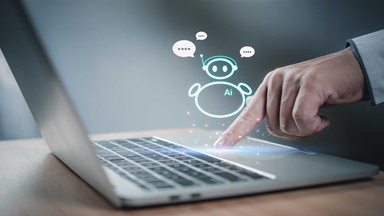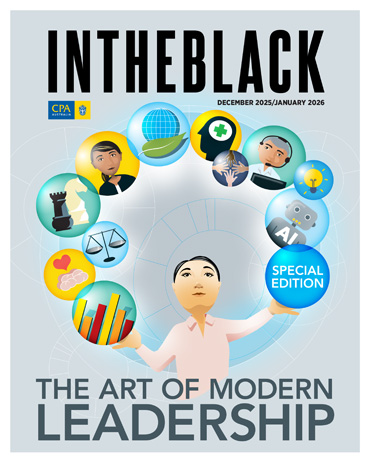Loading component...
At a glance
Generative artificial intelligence holds the promise of more productivity with less effort and better results. It is no wonder that the launch of ChatGPT in late 2022 saw a million users sign up within the first five days. Within two months, 100 million users had become active.
Among ChatGPT’s early adopters was Jason Robinson CPA, director at Future Advisory, who says now is the time to assess the capabilities of generative AI and be part of history.
“When used well, these systems can quickly extract and analyse content … to collate information and data, to respond to a user’s specific questions, to produce written materials and even undertake mathematical tasks,” he says.
“Like other significant developments in history, generative AI will get things wrong, and it will cause major issues, but either way we’re going to push forward – it’s here, and it’s not going away.”
What is generative AI?
At its essence, generative AI is a class of artificial intelligence algorithms that can generate or create content – text, images, music and even video – without any direct human intervention.
Early adopters across all areas of society and business are putting the technology to work, discovering and taking advantage of the opportunities it holds. In the process, they are also making mistakes and learning from them.
The accounting industry is no exception, with many firms already starting to see the possibilities of generative AI. This includes streamlining previously manual tasks, such as creating financial reports, performing data analysis and generating forecasts.
The technology can also be used to analyse large volumes of financial data, detecting trends and patterns that would be challenging for a human to identify.
Working with the machines
Tim Timchur FCPA, director at IT firm 365 Architechs, says generative AI is a powerful tool for day-to-day business operations – provided you know what you are asking it to do.
“The prompt you put in is crucial,” he says. “The more information you give it the more specific it will be.
“The best advice we have for accountants is to start engaging with it now, develop a policy for its use and train your staff to be able to see where it can best be used. It is not really an option not to use it,” Timchur says.
If a user asks ChatGPT to come up with some ways accountants can use it, within a few seconds it produces a list of tasks – expense tracking and receipt scanning, compliance and audit support, customer queries, data analysis, forecasting and budgets.
However, ChatGPT also offers the following warning:
“’It’s important to note that while ChatGPT can be a valuable tool, it should complement human expertise, and accountants should exercise discretion when relying on AI for critical financial decisions.
“Additionally, data privacy and security considerations should always be a priority when using AI in accounting practices.”
For Robinson, a warning like that should not be ignored, and users should be aware the technology is in its infancy.
“At the moment, it’s very experimental. There’s no guarantee that the answer you’re going to get back is correct, so it is important to have some processes in place to be able to check everything before you send it out,” he says.
The system is designed to make you think it is providing you with correct information – it wants you to believe it, Timchur says.
“Left to their own devices, these systems will ‘hallucinate’, which is the term that is widely accepted for it ‘making stuff up’.
“It is designed to convince you that what it said is accurate, and it will go to the extent of making up articles and referencing those articles to convince you,” Timchur says.
Robinson points to a response he got to a query about a client’s tax status as a sole trader.
“It told me a barrister in Victoria could operate under a company structure. I knew that to be untrue, and when I interrogated Chat GPT, it told me that it was wrong and even showed me how it had got the information wrong.
“It was a convincing answer, though, and if I hadn’t questioned it, it could have been a very different outcome with that client,” Robinson says.
“The simple mitigation strategy is simply to review and check, and not just blindly go along with what it’s telling you.”
Understand the security and privacy risks
Like any ground-breaking technology, there are security and privacy risks attached to the use of generative AI.
The best way to mitigate those risks is to not share any private or identifiable information with the platform.
“We’ve created procedures for our firm to never share information about who the client is or provide specific information about their business, such as ABNs, tax file, numbers, names. We always use it almost like a fake avatar or a fake character,” Robinson says.
This kind of approach is critical, says Matt Dunn, director at cyber security and technology company The Missing Link. However, as the technology is further developed, there will be stricter protections available.
“Up until now we’ve seen accounting firms using it more in their back-office functions, such as marketing and sales, and for client communications, newsletters and even developing draft agreements,” Dunn says.
With the recent announcement of Chat GPT Enterprise, which offers enhanced security and privacy features, advanced data analysis capabilities and customisation options, Dunn says professional services firms will be able to use the technology more safely for tasks like financial analysis.
“That includes collating messy client data, analysing it and preparing draft financial statements with commentary on the numbers.
“It’s very good at putting together analysis on numbers that aren’t necessarily all that clean, and we’ve actually tested it on public financial statements, and it does a great job of providing insights and financial ratios as well as forecasting,” Dunn adds.
Productivity gains ahead
The productivity gains offered by generative AI are enormous, Dunn says, most significantly in the way it performs mundane tasks.
“MIT did a study recently of about 450 ‘white collar’ employees, and the average increase in their productivity simply by using ChatGPT effectively was 37 per cent.
“That’s a massive boost for any firm adopting it in terms of their profitability, but also just in society in general, us being able to work on higher level tasks and being more productive and more creative as well as a result,” Dunn says.
Robinson also points to the boost in productivity that generative AI can bring, bearing in mind that the more information you give it, the better its responses will be.
“You’ve got to give context, character and set the challenge that you want it to do, and you have to be really clear [on] what you’re expecting,” he says.
“For example, to generate an email response to a client, you need to tell Chat GPT that it’s acting as an accountant to assist you to reply to some client emails. So, there it’s got the character – it’s a tax accountant.
“The context is, I need help replying to emails. And then the challenge will be to draft a response to an email that I copy and paste in.”
Being able to use the technology in this way frees up time for a senior employee who may then only need to check the response before sending, but it also helps develop more junior staff.
“It allows you to fast-track juniors and administrative and bookkeeping teams – assisting with some of these responses may have been out of their league before, but now they’re able to verify the information using AI and then have it approved by an accountant before it goes out to the client,” Robinson says.
What is clear is that this is the time for testing generative AI and, while there are already benefits being released, there is more to come.
“You’re either part of this ongoing development of civilisation and you jump on board to test it, or you sit back and watch everybody else dive in,” Robinson says.

